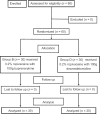Efficacy of Intra-articular Dexmedetomidine versus Buprenorphine for Postoperative Analgesia following Knee Arthroscopy: A Comparative Study
- PMID: 31198235
- PMCID: PMC6545935
- DOI: 10.4103/aer.AER_33_19
Efficacy of Intra-articular Dexmedetomidine versus Buprenorphine for Postoperative Analgesia following Knee Arthroscopy: A Comparative Study
Abstract
Background: Arthroscopic knee surgery is most commonly performed minimally invasive surgical procedure in orthopaedics. Postoperative pain relief is must for early mobilisation that reduces patient's morbidity and improves postoperative recovery.
Aims and objectives: We sought to compare analgesic efficacy of intraarticular buprenorphine with dexmedetomidine following arthroscopic surgery of knee.
Settings and design: A prospective , randomized controlled double blinded study was conducted involving 60 patients undergoing arthroscopic knee surgery.
Materials and methods: Patients were allocated into group B (n = 30) and group D (n = 30) receiving 100 μg of intraarticular buprenorphine and 100 μg of intraarticular dexmedetomidine respectively. Parameters observed were the time to first rescue analgesia , the number of patients requiring rescue analgesia with in next 24 hours, Visual analogue scale (VAS) at rest and on mobilization at 1st, 2nd, 4th, 8th, 12th and 24th hour.
Statistical analysis: Quantitative data were analyzed by unpaired student's t test and categorical data by Fisher's exact test. A P < 0.05 was considered to be significant. Statistical analysis was done using Statistical Package for the Social Sciences (SPSS 19.0, SPSS Inc., Chicago, IL, USA).
Results: Time to first rescue analgesia was significantly longer in patients receiving in group B. VAS scores at rest were comparable between the groups at 1st, 2nd, 4th and 8th hour but significantly low with intraarticular buprenorphine than intraarticular dexmedetomidine at 12th and 24th hour. VAS scores on ambulation were comparable at 1st, 2nd and 4th hour but significantly higher in dexmedetomidine group as compared to buprenorphine at 8th, 12th and 24th hour.
Conclusion: Intraarticular buprenorphine 100 μg provides longer duration of analgesia with decreased postoperative rescue analgesic requirement as compared to 100 μg intraarticular dexmedetomidine.
Keywords: Buprenorphine; dexmedetomidine; intra-articular; postoperative analgesia.
Conflict of interest statement
There are no conflicts of interest.
Similar articles
-
Comparative Study Between Dexmedetomidine and Fentanyl as an Adjuvant to Intraarticular Bupivacaine for Postoperative Analgesia after Knee Arthroscopy.Pain Physician. 2021 Nov;24(7):E989-E996. Pain Physician. 2021. PMID: 34704709 Clinical Trial.
-
Dexamethasone and Dexmedetomidine as an Adjuvant to Intraarticular Bupivacaine for Postoperative Pain Relief in Knee Arthroscopic Surgery: A Randomized Trial.Pain Physician. 2017 Nov;20(7):671-680. Pain Physician. 2017. PMID: 29149146 Clinical Trial.
-
Pain relief after Arthroscopic Knee Surgery: A comparison of intra-articular ropivacaine, fentanyl, and dexmedetomidine: A prospective, double-blinded, randomized controlled study.Saudi J Anaesth. 2014 Apr;8(2):233-7. doi: 10.4103/1658-354X.130727. Saudi J Anaesth. 2014. Retraction in: Saudi J Anaesth. 2020 Jul-Sep;14(3):422. doi: 10.4103/1658-354X.285417. PMID: 24843339 Free PMC article. Retracted.
-
Postsurgical analgesic efficacy by the intra-articular administration of ropivacaine with dexmedetomidine versus simple ropivacaine in patients undergoing knee arthroscopy.Rev Esp Cir Ortop Traumatol. 2024 May-Jun;68(3):306-312. doi: 10.1016/j.recot.2022.12.001. Epub 2022 Dec 22. Rev Esp Cir Ortop Traumatol. 2024. PMID: 36567063 Review. English, Spanish.
-
[Translated article] Postsurgical analgesic efficacy by the intra-articular administration of ropivacaine with dexmedetomidine versus simple ropivacaine in patients undergoing knee arthroscopy.Rev Esp Cir Ortop Traumatol. 2024 May-Jun;68(3):T306-T312. doi: 10.1016/j.recot.2024.03.001. Epub 2024 Mar 8. Rev Esp Cir Ortop Traumatol. 2024. PMID: 38461890 Review. English, Spanish.
Cited by
-
The Efficacy of Buprenorphine in Preoperative and Postoperative Patients: A Literature Review.Cureus. 2024 May 15;16(5):e60341. doi: 10.7759/cureus.60341. eCollection 2024 May. Cureus. 2024. PMID: 38883082 Free PMC article. Review.
References
-
- Dye SF, Vaupel GL, Dye CC. Conscious neurosensory mapping of the internal structures of the human knee without intraarticular anesthesia. Am J Sports Med. 1998;26:773–7. - PubMed
-
- Al-Metwalli RR, Mowafi HA, Ismail SA, Siddiqui AK, Al-Ghamdi AM, Shafi MA, et al. Effect of intra-articular dexmedetomidine on postoperative analgesia after arthroscopic knee surgery. Br J Anaesth. 2008;101:395–9. - PubMed
-
- Allen GC, St Amand MA, Lui AC, Johnson DH, Lindsay MP. Postarthroscopy analgesia with intraarticular bupivacaine/morphine. A randomized clinical trial. Anesthesiology. 1993;79:475–80. - PubMed


